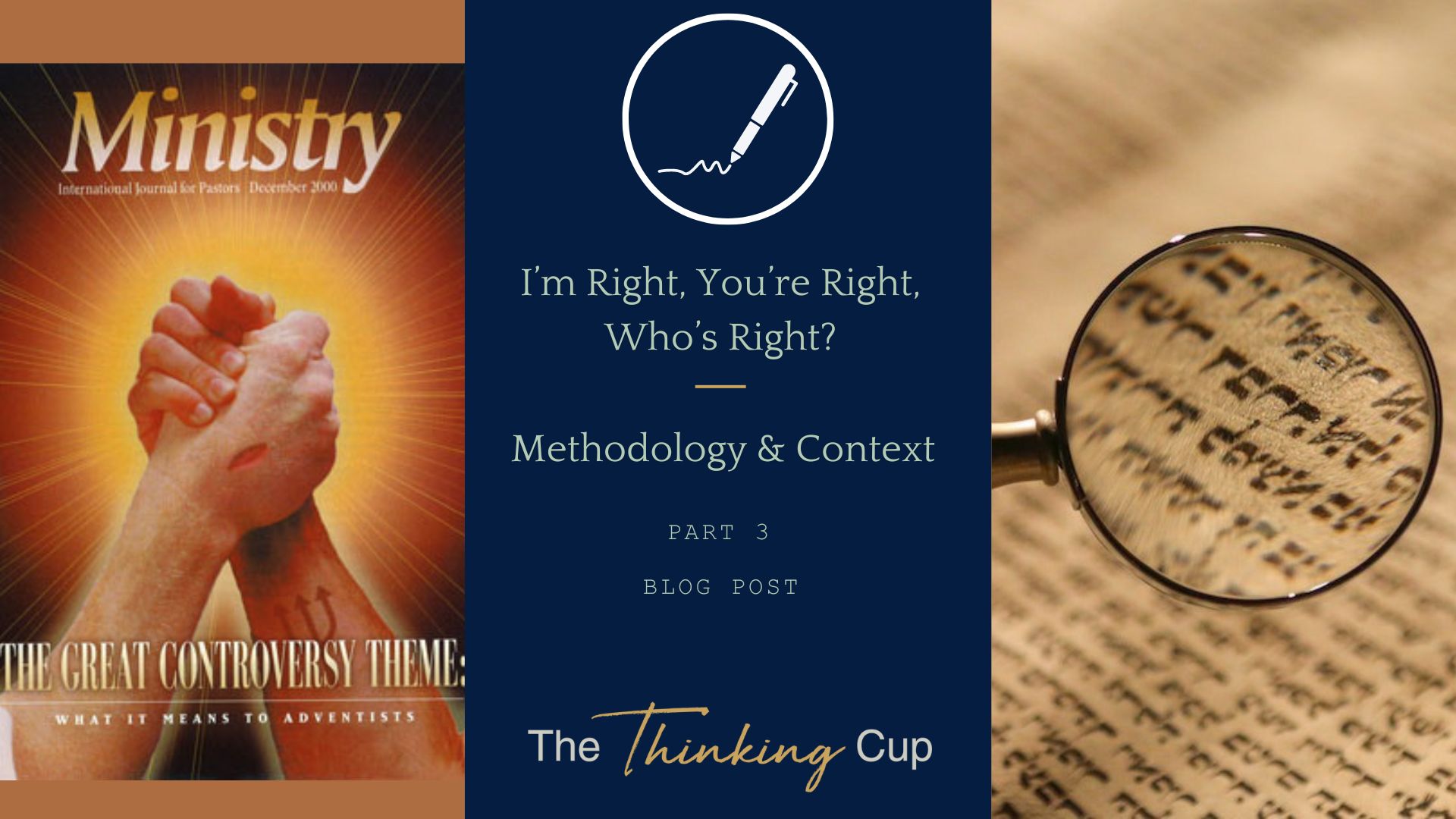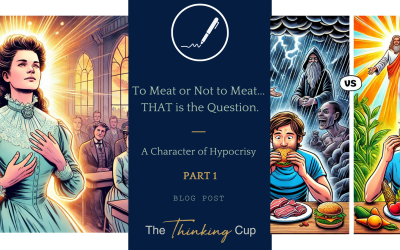It is essential to recognize and flesh out what we bring to the text. We all do this, even if we don’t realize it. Our personal presuppositions and worldview will shape how we see the ‘truths’ in the text. I have learned this reality all too well as I’ve emerged from the Seventh-day Adventist framework. We all learn to have a lens through which we interpret and guide our way of thinking. I was informed of this framework for Adventism from the research of Myles Christian at Answering Adventism (answeringadventism.com). He shared an article from Ministry Magazine with me. It’s important to understand that Ministry Magazine is an official website of the Seventh-day Adventist Church. I’ll read their mission statement to understand the context of what the magazine represents before we move further:
“Ministry is an international professional journal published monthly by the Ministerial Association of the General Conference of the Seventh-day Adventist Church, directed primarily to Adventist pastors and religious professionals and then to clergy of other religious groups on a bimonthly basis.
As with the first issue, so the mission of Ministry remains to deepen spiritual life, develop intellectual strength, and increase pastoral and evangelistic effectiveness of all ministers in the context of the three angels’ messages of Revelation 14:6-12.” [1]
Clearly, the Ministry Magazine functions as a means for the Seventh-day Adventist church to deepen, develop, and increase its ministers’ pastoral and evangelistic effectiveness regarding the three angels’ messages. This will then be further passed on to the laity under the leadership of these pastors and evangelists. So, something expressed in the Ministry Magazine carries the weight and views of the church at large, and the hope is that these views will be disseminated to the larger body of the church. For these reasons, I say the Ministry Magazine is an official marketing organ of the Seventh-day Adventist church designed to express the opinions and beliefs of the church proper.
Many who are unfamiliar with the Adventist framework have never heard of the Great Controversy Theme. But for Adventists, this theme is everything. In fact, it is necessary to understand why the church interprets specific passages the way it does.
Herbert E. Douglass ThD, a retired president of Weimar Institute, wrote this in his article titled The Great Controversy Theme: What it means to Adventists in the December 2000 edition of Ministry: (Yes, it’s a long quote, and I’ve emphasized a few thoughts in the quote in bold. If you want a direct link to this article: Ministry Magazine)
“For Seventh-day Adventists, the GCT (Great Controversy Theme) is the core concept that brings coherence to all biblical subjects. It transcends the age-old divisions that have fractured the Christian church for centuries. It brings peace to theological adversaries who suddenly see in a new harmony the truths that each had been vigorously arguing for. Herein lies the uniqueness of Adventism. That uniqueness is not some particular element of its theology, such as its sanctuary doctrine. Rather, the distinctiveness of Adventism rests in its overall understanding of the central message of the Bible that is governed by its seminal, governing principle the Great Controversy Theme.
Every philosophical or theological system builds on a central, governing theme or paradigm. Its central theme becomes that system’s core truth and determines all of that system’s principles and policies. Stephen Hawking, the remarkable Cambridge physicist (cosmologist), wrote in his 1988 book, A Brief History of Time, that should scientists discover the long-sought “theory of everything” to explain the varying mechanisms of the universe, “we should know the mind of God.“Seventh-day Adventists have been given that a perspective which provides a “theory of everything.” It introduces us to the “mind of God.” We didn’t discover it; it was given to us. We call it the Great Controversy Theme.
How we understand this core theme directly affects how we grasp the intent of biblical writers when they used words such as righteousness, salvation, gospel, etc. The GCT helps us to work our way through centuries of theological confusion over the meaning of such realities as justification, sanctification, atonement, obedience, and works. Without the GCT, all would remain divided over such subjects as the importance of the Old Testament sanctuary service and the New Testament view of Christ as our High Priest/Mediator, the meaning of faith and grace, the place of obedience in relation to legalism, why Jesus came the first time, why He came the way He did, and when He will return.” [2]
So, understand that Adventism brings its own worldview to the text. The GCT is the core concept that brings unity to ALL subjects for an Adventist. This concept wasn’t derived from the Biblical text but rather ‘given to us.’ This is the lens that helps an Adventist know the ‘mind of God.’ This perspective does the heavy lifting around all the easy and challenging subjects, bringing clarity to all the confusion among other denominations in areas like ‘justification, sanctification, atonement, obedience, and works.’
Whether you like it or not, this is the approach the Adventist system brings to the text when doing Bible Study. We all do something similar. We use a specific method when we interpret something, whether we know it or not. The outcome of our interpretation is shaped by the method we choose, which is why it’s crucial to understand our approach before beginning a study of the Bible. We believe the Bible to be divinely inspired, and while there are various methods for studying it, the one I’ve found most respectful and effective is the exegetical approach. This method acknowledges that none of the Bible was written with a modern audience in mind. It was composed thousands of years ago in languages and cultures that are vastly different from those we live in today. The exegetical method also emphasizes that the Bible’s messages were intended to be understood by the original audience and had specific meanings for them. Therefore, before fully grasping its relevance to us today, we must first comprehend what it meant to its initial readers.[3]
The Context of the Bible
I have often heard it said, “You are taking that out of context!” What does a person really mean when they say this? Are they referring to the contexts of the passage being discussed? Or are they just claiming that the interpretation doesn’t line up with their interpretation? What does context even mean? The Bible is a different type of document. Different than any other compiled book. We must consider several different contexts in order to honor the ancient text as it is: an ancient sacred text. While there are many different contexts one could consider, we are only going to discuss a few of the most important. These include the textual context, the literary context, the historical context, the political context, and the theological and philosophical contexts.
“A text without a context is a pretext!”
The Textual Context
Before the invention of printing in 1453, the only way to preserve ancient documents was by copying them by hand. This manual process led to many variations in the Hebrew, Aramaic, and Greek manuscripts in which the scriptures were originally written. Today, there are thousands of ancient manuscripts of the Bible, but no two are identical, and none of the original writings from the authors have survived. So, before interpreting the text, we must first establish if the version we have is the earliest and closest to the original. While this might seem overwhelming, scholars have been using scientific methods for centuries to sort through these variations, resulting in the coherent Bibles we have today. Many Christians may not realize that this method, known as Textual Criticism, is why we can read a reliable version of the Bible today. Although regular readers might not fully understand or apply all the tools of this method, it’s essential to recognize its existence and its impact on the meaning of Scripture. As we delve into the issue at hand, we will explore how understanding specific texts is shaped by what we consider to be the original wording of those passages.
Literary Context
The literary and grammatical context involves several key aspects, including 1) How the author organized their words, 2) The original meaning of words and phrases at the time they were written, 3) The author’s unique writing style, 4) The type of writing the author used, such as prose, poetry, or apocalyptic literature. These factors are crucial when studying the Bible as a whole, as well as when we focus on specific ideas within Scripture.
Historical Context
The historical context involves factors such as who wrote the text, where and when it was written, and who it was intended for. It also considers the political, social, and cultural conditions of the time. As previously mentioned, the books of the Bible were written at different times, for different audiences, and under diverse historical circumstances. Each author had their own writing style and dealt with unique issues, so these historical elements must be considered to fully understand the meaning of any passage.
Political Context
The political setting is a part of the historical context that looks at the social and political conditions during the time a text was written. This aspect is important because the political environment influences the meaning of the biblical text. For instance, when the book of Revelation was written, emperor worship was required in many areas of the Roman Empire. Every Roman citizen had to burn incense on an altar to Caesar’s divinity once a year, after which they received a certificate allowing them to participate in trade. Cities like Smyrna and Ephesus were major centers of emperor worship.
In Ephesus, for instance, there was an inscription dedicated to Caligula that stated:
“The council and the people of Ephesians and other Greek cities, which dwell In Asia and the nations (acknowledged) Gaius Julius Caesar Germanicus [otherwise called Caligula], the son of Gaius Caesar as High Priest and absolute ruler… The God visible who is born of (the gods) Ares and Aphrodite, the shared Savior of human life.” [4]
According to the Roman historian Suetonius, Domitian also referred to himself with grand titles like Dominus et Deus, meaning Lord and God.[5]
The Book of Revelation was written around AD 95-96; this is based on many of the early church fathers’ accounts with regards to the Apostle John being exiled on Patmos Island during the reign of Domitian, who died in A.D. 96. After this, John was returned to Ephesus. So it is clear that John wrote Revelation during this political climate, which helps shed light on John’s strong emphasis on the worship of God and his message regarding the mark of the beast and the seal of God (Revelation 13:18). As we will explore later, these political aspects have significant relevance for understanding the Sabbath as possibly being the seal of God, in contrast to Sunday worship as the mark of the beast.
The Theological and Philosophical Context
The theological and philosophical context focuses on what each biblical author believed, shaped by their worldview at the time of writing. For example, the book of Samuel says the Lord caused David to take a census of Israel.
Again the anger of the Lord was kindled against Israel, and he incited David against them, saying, “Go, number Israel and Judah.” (2 Sa 24:1)
However, in the book of Chronicles, the ha satan (adversary) is described as the one who prompted David to do so.
Then Satan stood against Israel and incited David to number Israel. So David said to Joab and the commanders of the army, “Go, number Israel, from Beersheba to Dan, and bring me a report, that I may know their number.” (1 Ch 21:1–2)
It can be challenging to make sense of these passages without understanding the different theological viewpoints at play. On a side note, one should also understand the original language and how Hebrew grammar works to understand why ‘Satan,’ in this text, should NOT be capitalized and does NOT refer to the devil.
In Isaiah 56:6-7, there’s a mention of foreigners or Gentiles joining themselves to the Lord and honoring His Sabbaths.
“And the foreigners who join themselves to the Lord, to minister to him, to love the name of the Lord, and to be his servants, everyone who keeps the Sabbath and does not profane it, and holds fast my covenant— these I will bring to my holy mountain, and make them joyful in my house of prayer; their burnt offerings and their sacrifices will be accepted on my altar; for my house shall be called a house of prayer for all peoples.” (Is 56:6–7)
Later, near the end of Isaiah 66, Isaiah continues to emphasize the Sabbath, stating,
“For as the new heavens and the new earth that I make shall remain before me, says the Lord, so shall your offspring and your name remain. From new moon to new moon, and from Sabbath to Sabbath, all flesh shall come to worship before me, declares the Lord. (Is 66:22–23)
Did Isaiah require Sabbath observance for all people at all times? Without a deeper understanding of his theological and philosophical context, we will struggle to properly understand these texts and their contexts.
An important part of the theological context is recognizing that biblical writers came from different theological backgrounds. Therefore, a New Testament text should not be used to determine the exact meaning of an Old Testament passage within its original context. Later writers often reinterpreted earlier texts to make a point similar yet distinct from the original. For instance, in Matthew 2:15, Matthew reinterprets Hosea 11:1-2, portraying Jesus as the new Israel. But if we look at Hosea in its original context, it becomes clear that Matthew’s New Israel is not the same as Hosea’s Israel. Hosea’s Israel was a disobedient, idolatrous nation. In contrast, Matthew’s New Israel—Jesus—was the obedient Son of God, in whom God was well pleased (Matthew 3:17). If we aren’t paying attention to the theological and philosophical context of the author, we will inaccurately insert our own theology and philosophy into the text.
Cultural Context
We could probably summarize all of the previous contexts under the term “cultural context.” As is widely understood, culture encompasses a people’s entire way of life, including their theological, philosophical, political, and social expressions. The Bible was not written in isolation but was communicated through Hebrew and other ancient cultures. We will likely misinterpret the Bible’s message without understanding these cultural backgrounds.
A quick example can be found in Exodus 25:16, 21-22; 40:20, where God instructed Moses to place the stone tablets of the Ten Commandments in the Ark of the Covenant beneath the covering cherubim. In the ancient world, whenever a ruling king (a suzerain) made a covenant with a subjected people (vassals), a copy of the covenant document was placed in the temples at the feet of the gods, typically represented by an idol. This signified that the gods were witnesses to the binding agreement between the two parties. In Israel’s temple, there was no idol; instead, the cherubim above the Ark symbolized Yahweh. Placing the stone tablets in the Ark under the cherubim meant they were placed at Yahweh’s feet. This was a constant reminder to both Israel and Yahweh that they were bound together as covenant partners. The significance of this cultural practice in relation to the Ten Commandments—and particularly the Sabbath—should become clear when studied within its cultural context. This is not the space to elaborate on the details of the Sabbath and the Ten Commandments within the context of the Covenant, but if a person’s interpretation of the Sabbath and the Ten Commandments does not take into account its context, then the interpretation will be miss-leading and faulty.
In conclusion, when interpreting a text, we must first ask several important questions:
-
- Are there any textual variations in the passage?
- Who authored the text, and what language and genre were used?
- Who was the intended audience?
- What issues prompted the writing of the text?
- What were the philosophical positions and worldviews of the time?
- What cultural practices were in place when the document was written, and how do these practices influence the text?
- How did the people to whom the text was addressed understand it at the time?
Unfortunately, when the Adventist pioneers established many of the church’s doctrines, they did not follow the basic principles of exegesis. Instead, they unknowingly used the Prooftext method to develop the current SDA stance on many doctrines.
The Prooftext method overlooks or confuses the different contexts that are essential when interpreting the Bible. It begins with a preformed idea and then finds a passage to back it up, leading to a situation where meaning is imposed on the text rather than drawn from it. For example, when the Bible mentions the word “law,” this method often interprets it as the Ten Commandments when it is in a positive context and as ceremonial law when in a negative context.
From an exegetical standpoint, however, understanding the Hebrew or Greek word for “law” starts with the immediate context of the text. Then, various other contexts—such as literary, theological, philosophical, and cultural—are examined based on the author before determining the precise meaning. When approached this way, it becomes clear that the distinction between moral and ceremonial law doesn’t exist in Scripture. Any conclusion based on this distinction is merely unsupported proof-texting, which does not accurately reflect the Bible’s teachings. Furthermore, an exegetical approach reveals that ancient laws were not isolated rules but gained their meaning from the covenant systems they were part of.
As we conclude this discussion on context and the exegetical method for studying the Bible, it’s important to address the misconception that this method is purely humanistic, excluding the Holy Spirit. This view couldn’t be more wrong. Since the Bible was written within specific contexts, established by the Spirit of God, it follows that God intends for us to understand the Bible in those contexts. Thus, using the exegetical method to acknowledge these contexts is not a human approach but a spiritual one. The truth is that spiritual understanding requires structure and method so that we can discern the work of the Spirit. Relying solely on emotional or mystical experiences isn’t a reliable guide for Bible study, especially when such study is meant to lead a whole community of believers. There must be core spiritual principles that everyone can see as reasonable and practical. The Prooftext method, which ignores contexts, is not a spiritual approach. Additionally, most people naturally gravitate toward the Prooftext method without realizing it, so it’s crucial to consciously adopt the exegetical approach. Without it, we are left with a method that is far from spiritual – The Proof-Text method.
I hope it is becoming clear that studying the Bible in a way that respects the text and upholds Scripture is challenging but necessary work. On the other hand, the Prooftext method, while quick and easy, can be extremely dangerous. This approach has been used to justify harmful practices like slavery, apartheid, racism, classism, and rigid denominationalism. In fact, any stance someone wants to support can be justified using the Prooftext method. Unfortunately, as presented by the church and its members, many of the Seventh-day Adventist doctrines are based on this approach, as can be seen through a few examples.
But this will be the nature of my next post!
In Christian Love,

[1] Ministry Magazine, “About Us.”
[2] Douglass, “The Great Controversy Theme: What It Means to Adventists.”
[3] Baldwin, The Person of Jesus: God’s Obligatory Sabbath, pg. 15.
[4] Ehrman, The New Testament: Historical Introduction to Early Christian Writings, Pg. 29.
[5] Suetonius, Domitian Xiii.




0 Comments